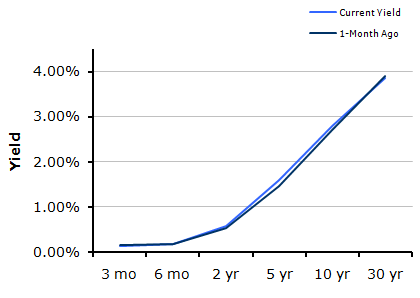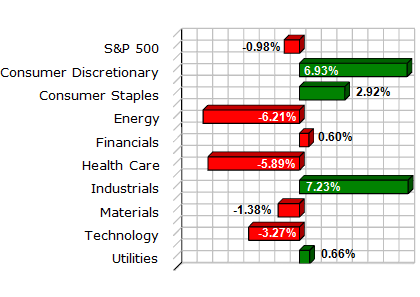
Market Commentary by Scott J. Brown, Ph.D., Chief Economist

The economic data calendar was thin. The Fed’s Beige Book, the summary of anecdotal conditions from the 12 Federal Reserve districts, noted “widespread signs of a deceleration” in national economic activity (that means slower growth, not a double dip). After rising in August, claims for unemployment insurance benefits fell back to 451,000. However, it’s unclear whether August figures were distorted (possibly by classification errors related to the extension of unemployment insurance benefits) or whether the latest week was distorted (as the Labor Day holiday led to delays in state reports to the Labor Department). The trade deficit narrowed in July, after widening sharply in June.
Stock market participants were apparently encouraged by the view that the economy will likely avoid a double dip, but were not exactly ecstatic (in that growth is still expected to be subpar in the near term). Bond yields rose. Market activity was light due to the holidays (Labor Day, Rosh Hashanah).
Next week, the mid-month economic data will set the stage for the September 21 Federal Open Market Committee meeting. According to Chairman Bernanke, the Fed is prepared to take further efforts to support economic growth (buying more Treasuries and mortgaged-backed securities). However Fed officials do not yet feel that the potential benefits outweigh the potential risks of such a strategy.
This week’s economic data reports are unlikely to force the Fed’s hand toward further action. Retail sales are expected to post a lackluster gain in August. Industrial production should have risen moderately. Seasonal adjustment in gasoline prices will provide a small boost to the Consumer Price Index, but core inflation is expected to remain mild.
Indices
| Last | Last Week | YTD return % | |
| DJIA | 10415.24 | 10320.1 | -0.12% |
| NASDAQ | 2236.2 | 2200.01 | -1.45% |
| S&P 500 | 1104.18 | 1090.1 | -0.98% |
| MSCI EAFE | 1500.27 | 1471.96 | -5.09% |
| Russell 2000 | 634.62 | 632.26 | 1.48% |
Consumer Money Rates
| Last | 1-year ago | |
| Prime Rate | 3.25 | 3.25 |
| Fed Funds | 0.25 | 0.25 |
| 30-year mortgage | 4.36 | 5.23 |
Currencies
| Last | 1-year ago | |
| Dollars per British Pound | 1.544 | 1.656 |
| Dollars per Euro | 1.270 | 1.457 |
| Japanese Yen per Dollar | 83.810 | 91.940 |
| Canadian Dollars per Dollar | 1.034 | 1.077 |
| Mexican Peso per Dollar | 13.052 | 13.444 |
Commodities
| Last | 1-year ago | |
| Crude Oil | 74.25 | 71.31 |
| Gold | 1246.60 | 996.60 |
Bond Rates
| Last | 1-month ago | |
| 2-year treasury | 0.57 | 0.54 |
| 10-year treasury | 2.79 | 2.71 |
| 10-year municipal (TEY) | 3.55 | 4.14 |
Treasury Yield Curve – 9/10/2010

S&P Sector Performance (YTD) – 9/10/2010

Economic Calendar
| September 14th | — | Retail Sales (August) Business Inventories (July) |
| September 15th | — | Industrial Production (August) Empire State Manufacturing Index (September) Industrial Production (August) |
| September 16th | — | Jobless Claims (week ending September 11th) Producer Price Index (August) Current Account Deficit (2Q10) Philadelphia Fed Index (September) |
| September 17th | — | Consumer Price Index (August) Real Weekly Earnings (August) |
| September 21st | — | Building Permits, Housing Starts (August) FOMC Meeting |
| September 23rd | — | Existing Home Sales (August) Leading Economic Indicators (August) |
| September 24th | — | Durable Goods Orders (August) New Home Sales (August) |
| October 8th | — | Employment Report (September) |
Important Disclosures
Past performance is not a guarantee of future results. There are special risks involved with global investing related to market and currency fluctuations, economic and political instability, and different financial accounting standards. The above material has been obtained from sources considered reliable, but we do not guarantee that it is accurate or complete. There is no assurance that any trends mentioned will continue in the future. While interest on municipal bonds is generally exempt from federal income tax, it may be subject to the federal alternative minimum tax, state or local taxes. In addition, certain municipal bonds (such as Build America Bonds) are issued without a federal tax exemption, which subjects the related interest income to federal income tax. Investing involves risk and investors may incur a profit or a loss.
US government bonds and treasury bills are guaranteed by the US government and, if held to maturity, offer a fixed rate of return and guaranteed principal value. US government bonds are issued and guaranteed as to the timely payment of principal and interest by the federal government. Treasury bills are certificates reflecting short-term (less than one year) obligations of the US government.
Commodities trading is generally considered speculative because of the significant potential for investment loss. Markets for commodities are likely to be volatile and there may be sharp price fluctuations even during periods when prices overall are rising. Specific sector investing can be subject to different and greater risks than more diversified investments.
Tax Equiv Muni yields (TEY) assume a 35% tax rate on triple-A rated, tax-exempt insured revenue bonds.
![]() Material prepared by Raymond James for use by its financial advisors.
Material prepared by Raymond James for use by its financial advisors.
The information contained herein has been obtained from sources considered reliable, but we do not guarantee that the foregoing material is accurate or complete. Data source: Bloomberg, as of close of business September 9th, 2010.
©2010 Raymond James Financial Services, Inc. member FINRA / SIPC.


